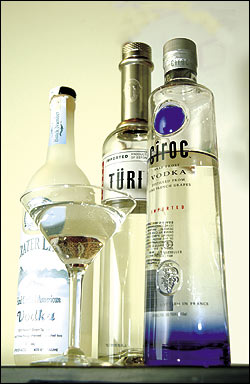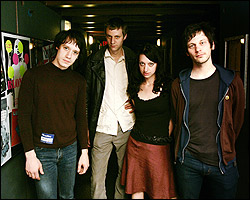Every few years, someone wants to have a conversation about how classic cocktails are making a comeback. Try telling the pickled- looking lady at the bar that they ever went away. First appletinis were the new gimlets, and then someone decided that gimlets were the new appletinis. Sunday is the new Friday, 32 is the new 21, and over the last few years, the trend has been to market artisanal, “ultrapremium” vodkas as the new consummate—or should I say “Absolut”?—liquors.
The popularity of syrupy yet dry Crater Lake vodka, which is distilled in small enough quantities that each bottle bears a handwritten batch number, by Bendistillery in Bend, Ore., as well as brands like Hangar One, made by St. George Spirits in Alameda, Calif., even give us cause to speculate that someday, Washington might also get in the small-batch liquor game. The reputation of West Coast wines grew up in California, took root in the great pinot noirs of Oregon, and is off and running thanks to our own grapes, so who’s to say that the same pattern won’t emerge in the production of vodkas—especially considering that a handful of the best and brightest vodkas on the market are made, in part at least, from grapes.
Distilled from French grapes, the fruit flavor in Ciroc vodka isn’t exactly something you taste; it’s something you chase. Having recently gathered four seasoned vodka drinkers to taste test some of the most popular micro- and premium distillations, I can tell you that half of them claimed to get crisp green grape in the second or third sip while the other half were more than content with the idea of subtle fruit that lingered in the glowing, nonburn of the relatively gentle liquor. Although it’s made with snap-frost grapes from the Gaillac region, Ciroc has little else in common with wine. Even the name distinguishes it from the dry whites that come from the same area. Ciroc is a made-up word derived from the French terms for “rock” and “peak”; a winemaker would’ve just called it cime roche.
After a palate-cleansing potato cake—topped with crème fraîche and ikura (salmon caviar) from the Seattle Caviar Company—we were on to Hangar One. Known for their grappa and eau de vie (both high-alcohol, high-sugar-content, grape-derived liquors usually reserved for after-dinner sipping), St. George Spirits stumbled upon what would become Hangar One Mandarin Blossom vodka after adding citrus rind and blossoms to eau-de-vie about three years ago. They tweaked the experiment so the final product would be a result of grain and viognier grape distillation, and St. George’s new vodka was born. Far from the dry, harsh orange burn of Absolut Mandarin, Hangar One’s take on citrus fruit has a tender flavor and a delicate but pronounced floral bouquet.
St. George also makes a kaffir lime vodka and a citron vodka called Buddha’s Hand, but they’re nearly impossible to find. Equally elusive are Napa’s Charbay vodkas flavored with Meyer lemons from Florida and key limes from Mexico. Hangar One Mandarin Blossom can be found in select liquor stores around the city, though you may have to settle for Hangar One Straight if you’re shopping in the outer neighborhoods—not that it’s second-best or anything. Where Ciroc’s packaging, with its goofy, lava lamp–like purple button of ooze near the neck, isn’t quite as ultrapremium as its aspirations, Hangar One has a sophisticated, clean look and feel. It’s a much better bottle to bring to a party, and since both run about 30 bucks and are comparable in terms of balance and flavor, you might as well choose the more aesthetically refined of the two.
AND IF YOU CAN, by all means, choose the most regional. Crater Lake is the current darling of the vodka set, and I even found it out in White Center at a liquor store situated within a smattering of Asian grocery stores. With an icy hot shimmer in place of any kind of discernable taste, the Oregon vodka is dry without being harsh and thick enough to be syrupy and rich even though it’s not exactly sweet.
“This reminds me, I’ve got to put some Crater Lake in the earthquake kit,” said my friend as he shook a martini. When the big one hits, he and his boyfriend will be sipping the most stylish vodka around. Stocking up on it doesn’t even break the bank; the 750 milliliter bottle is only $19.95. Although we ended up deciding that we liked Grey Goose—a relative commoner made in France—just about as much (and the Estonian Türi a little less), Crater Lake is definitely the bottle to show up with on New Year’s Eve, but you should try to get your friends to refrain from making silly drinks with it.
On their Web site, Bendistillery suggests that you sip their Crater Lake vodka straight or have it in a dry martini. They claim that because it’s filtered 10 times—through crushed lava rock, no less—their vodka is pure and smooth and totally drinkable. On the other hand, the folks who wrote the tips for Ciroc’s Web site suggest mixing a few “Ciroc-and-Rolls” at your next party. Sure, a blend of orange juice, Ciroc, and Red Bull (or any other energy drink) sounds like a perfectly fine way to get the party started, but if it’s going to be that kind of party, you’ll probably be just as well served by a lower-shelf vodka.
Given the unrelenting trend of mixing Dukuyper’s Sour Apple Pucker with it, vodka’s reputation as a sippable beverage may not be, in certain circles, altogether solid. While we tend to think of the potato as vodka’s main ingredient, it can be made from almost any sugar or starch, and different bases impart different tastes. Writing in The Atlantic this month, Corby Kummer says, “The real test of any vodka maker is unflavored vodka.” That there are so many straightforward, unfettered vodkas on the market—and a nice selection of them made so close to home—seems like ample reason to make vodka the official beverage for sampling in 2005, or at least on the eve of it.








